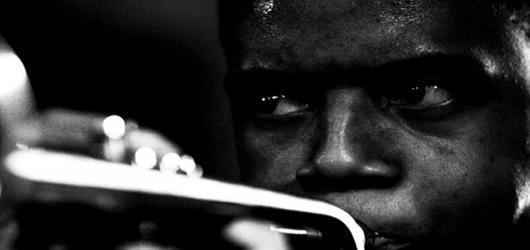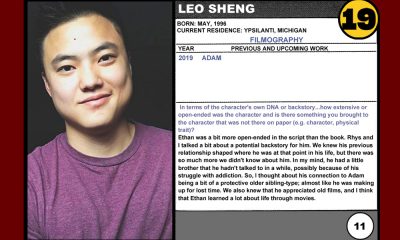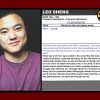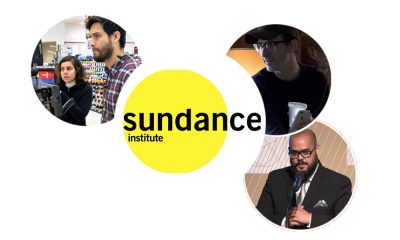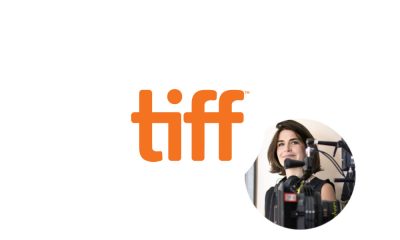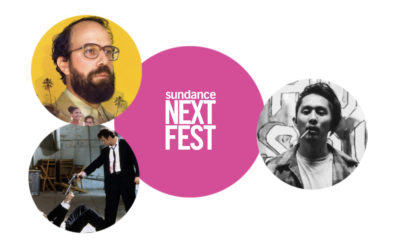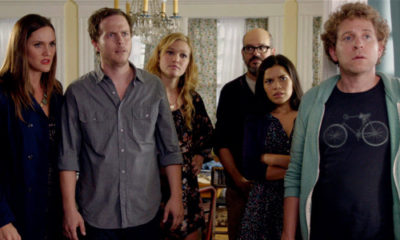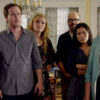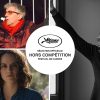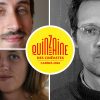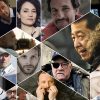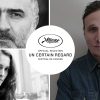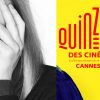Retro IONCINEMA.com
Damien Chazelle
For Guy and Madeline, if I had wanted to riff off Meet Me In St. Louis, I would have had to shoot in color. But if this movie’s a love letter to anything, it’s to the first musicals, when the genre was still this crazy and unpredictable beast that directors didn’t quite know what to do with.
IONCINEMA.com’s “IONCINEPHILE of the Month” puts the spotlight on an emerging filmmaker from the world of cinema, and this month’s helmer needs no introduction for all the critics that named his film among the best undistributed titles of 2009. I know of many burgeoning filmmakers committing to their first projects and I like this story: pulling out of Harvard with a thesis short film to then return three years later with a completed feature to graduate.
Guy and Madeline on a Park Bench appears to be the perfect marriage of Damien Chazelle’s twin passions: film and jazz Variance Films will be releasing his musical drama in theaters this Friday. Here’s our profile on the filmmaker and as always with this feature, you can read the filmmaker’s top ten films of all time by clicking here.
Eric Lavallee: During your childhood…what films were important to you?
Damien Chazelle: The old Disney cartoons:..Cinderella, Pinocchio, Dumbo, Sleeping Beauty. The Hitchcock movie where the boy takes the bomb on the bus – Sabotage. Louis de Funès comedies, like Rabbi Jacob and La Grande Vadrouille. There’s Something About Mary and Titanic. I still adore all of those.
Lavallee: During your formative years what films and filmmakers inspired you?
Chazelle: Vincente Minnelli and Leo McCarey. Meet Me In St. Louis and The Awful Truth. And Renoir’s Day in the Country. Those are perfect movies.

Lavallee: At what point did you know you wanted to become a filmmaker?
Chazelle: I never wanted to be anything else. When I was little I watched Disney cartoons, so I wanted to make those. Then I started watching live-action movies, so I wanted to make those. I drew a lot and made little movies on my dad’s camcorder. Then I decided better to get a well-rounded education than jump right into film school: if you want to be a good director, it’s just as useful to read Henry James or listen to Clifford Brown than to watch Hitchcock. So I went to Harvard, thinking I’d study literature or something. But I wound up studying film instead. From that point on I fell in love with 16mm, and that was that.
Feature Film:
Lavallee: What is the genesis of the project? I’m curious about the musical and romance angle.
Chazelle: I wanted to make a musical. I was a junior in college and asked my roommate if he’d write the score. He said yes. We were both 20, naïve, thought it’d be perfectly doable. Banded together with a few other students, starting working. It became my senior thesis, then grew past that. I shot most of it my senior year, but didn’t finish editing it until after I’d graduated. It went through some odd detours, but it’s pretty close now to what I originally thought it would be: a really rough-hewn musical. A lot of my favorite musicals have that scrappy, seat-of-your-pants quality: you see it in early Fred and Ginger pictures, early Mileston and Mamoulian stuff, early “soundies”. I wanted to adopt that approach: make a musical as though the genre were still new.
Lavallee: I imagine the selection of Jason Palmer and Desiree Garcia was based on their age demo as well as, their musical/dance skill-set? How long did the casting process last and what kind of characteristics/features were you looking for your main characters during the casting process?
Chazelle: I wanted young people. But what attracted me to Jason and Desiree was that they had their own lives, a world away from the camera. Jason is a trumpeter by trade, one of the best young musicians out there right now. Desiree was an academic, deep into a dissertation. They didn’t come into audition for the movie. I had to seek them out. That was part of the point, really. I wanted them to bring their own lives to the story. When Guy’s family shows up unannounced, that is really Jason’s family showing up unannounced. When Guy plays a gig at Wally’s Jazz Café, that is really Jason playing a gig at Wally’s Jazz Café. Finding everyone was a long process—almost none of the people in the movie, including Sandha Khin, who plays Elena, had ever acted on-screen before. It took six months before we were ready to shoot a frame. And then we shot over the course of a year and a half.

Lavallee: I imagine you had to prep for the performances in both the acting and musical sequences… Could you discuss if there was a rehearsal process for both or workshops?…and how did you prep for each scene and how close did you stick to your script/outline?
Chazelle: I wrote a full script, but most of the actors never saw it. It was a guideline for me, but only that. I’d describe a scene to the actors—tell them what beats to hit, what information to get across—and then let them do what they wanted. Sometimes one take was enough and we were done; other times we’d shoot and shoot and try different things for days. But it was important for me that it always feel as intimate as possible. A lot of the movie is straight-up documentary: Jason talking on the stoop of his building or teaching his mom how to play piano, Desiree teaching a kid how to use chop-sticks, Sandha getting the number of a juggler. That stuff just happened.
Lavallee: What ideas did you have for the style of the film? Was 16mm/B&W something you had in mind from the start? And finally, what inspirations (other films, location, paintings etc…) did you draw upon for the look/style, aesthetics (visual and aural) of the film?
Chazelle: Black-and-white was never a question. I never imagined the movie in color. It’s funny, because I’m writing another musical now, and I can’t imagine it in anything but color. For Guy and Madeline…, if I had wanted to riff off Meet Me In St. Louis, I would have had to shoot in color. But if this movie’s a love letter to anything, it’s to the first musicals, when the genre was still this crazy and unpredictable beast that directors didn’t quite know what to do with. And the world of those movies is a black-and-white world. So, inspirations… Hallelujah, I’m a Bum. Cabin in the Sky. St. Louis Blues. Top Hat. And the music…pure French. My favorite movie scores are French: all those circles of fifths. Justin (my composer) gorged on Legrand and Delerue and Constantin. No one’s ever written a better score than The 400 Blows. It’s a master class in how to use an orchestra. It’s one of the best pieces of twentieth-century music. And I say this as someone who thinks Thelonious Monk is every bit the equal to Bach. A few other random influences: Robert Frank photographs. Rivette movies. The titles of Rivette movies (Celine and Julie Go Boating, for example). A still from a Rivette movie called “L’amour fou” that I still have never seen—I saw the still on a theater wall and have never been able to get it out of my head. Old TV footage of Charlie Parker playing—he looks so uncomfortable on camera whenever his saxophone isn’t at his lips. Tropic of Cancer. The Young Girls of Rochefort. Krazy Kat. I don’t know if all these things worked their way into the movie, but they were all on my mind when I was making it.
Lavallee: I’m used to the likes of…Tarantino and Del Toro “presenting” films. How did Stanley Tucci become involved?
Chazelle: Tucci saw the film and liked it. It was a really simple process, but it happened after our festival run. I’m an enormous fan of both his acting and his directing, so it’s a real thrill.
Lavallee: Your film has traveled quite a bit – on both the international Film festival circuit and in U.S indie fests. Looking back, I’d like to know what piece of advice would you give to young filmmakers when it comes to selecting and submitting to festivals (at home in the U.S. and abroad)?
Chazelle: I’m not sure I have any real advice… Everything that happened to the movie on the festival circuit feels like it happened out of luck or chance. But there are a lot of great festivals out there. Start by submitting to your top choices. Then branch out. Be careful where you premiere—it’s an annoying game, but one you have to play—and then just have fun. I’ve discovered some of my favorite places in the world through festivals—not to mention movies, people, etc. It’s not all work.
Lavallee: Could you discuss the collaborative process you had with producer Jasmine McGlade.
Chazelle: Jasmine McGlade is a writer and director, not a producer. She’s editing her own first feature as we speak. She and I had worked on each other’s movies as juniors in college, and she was my go-to collaborator then. But when it came time to make Guy and Madeline, she did everything. Literally. From working the script to filming auditions to hitting the streets looking for passersby who might want to be in the film. Then from raising money to focus pulling to lighting to sound. She was there every step of the way. The climactic restaurant-set musical number was originally set in an office building. Jasmine suggested Summer Shack as a location, and I took her lead. The number is better as a result. A shower scene between Guy and Elena (the girl for whom he leaves Madeline) also sprang from an idea of Jasmine’s. Most important, she made sure I was able to make the movie I wanted to make. Full disclosure: I had such a great time working with her on the movie that I fell in love toward the end of the shoot. We’re now married.
Lavallee: Could you discuss the collaborative process you had with composer Justin Hurwitz.
Chazelle: As soon as I decided to make a musical, I asked Justin if he’d write the music. If he had said no, I wouldn’t have made the movie. He and I were college roommates at the time, and we spent a summer just sending tracks and script drafts back and forth. Together we listened to a lot of stuff: Legrand, Rota, Hermann, Debussy, Berlin, Gershwin, Mancini, Porter, Berlioz, Beethoven, Saint-Saëns, Ellington… As I said before, French music eventually became the real linchpin. There’s something about French musicians riffing on jazz—from Django Reinhardt to Piaf to Legrand—that’s just wonderful. It took about four months to nail the theme of the film—the simple cluster of notes we’d hang the rest of the score on. Then Justin built it all up from that. He approached the score as storytelling: the theme had to say one thing, and any other motifs that crept up had to say other things. The structure of the overture had to mirror the structure of the film. Certain characters were allowed certain kinds of orchestration, others weren’t allowed any music at all. This was all Justin. He was a real architect when it came to this.
Lavallee: Could you discuss the collaborative process you had with co-editor Adam Parker.
Chazelle: Adam helped me through the hardest part of the process: shaping hours upon hours of 16mm footage into an 82-minute film. Musical numbers got cut. Whole characters, subplots, storylines—dropped. Ironically, the movie that resulted is pretty damn close to the original script. It was important to me that the movie have rhythm. Not just when it came to the music, but to the silences as well, the quiet moments. Look at how Rohmer films are cut: almost no music whatsoever, but the cuts all feel rhythmically justified. Those are incredibly musical movies. I’m a drummer, and Adam is a singer. He’s also a writer and director. It all fed into the editing—our backgrounds, our instruments, our tastes. It’s all there. Plus a little Rohmer.
Variance Films releases Damien Chazelle’s Guy and Madeline on a Park Bench in NYC’s Cinema Village on November 5th. Check the official site for future screenings/listings.



